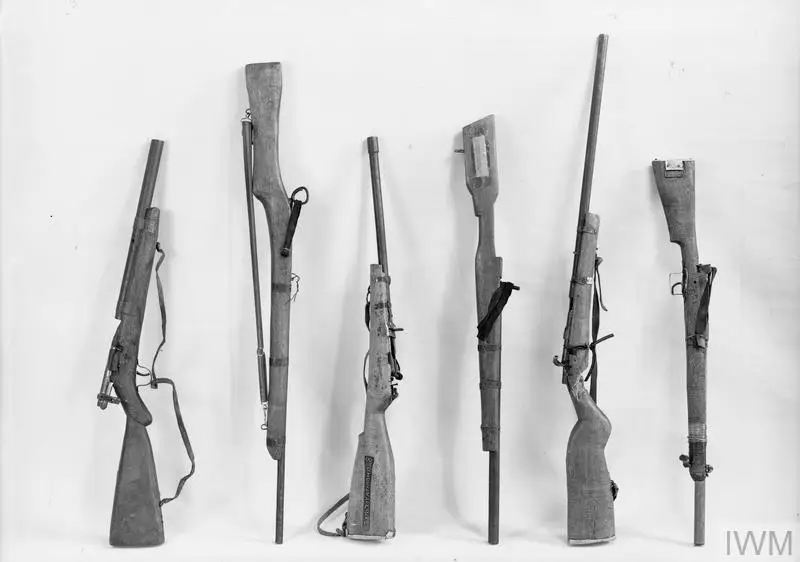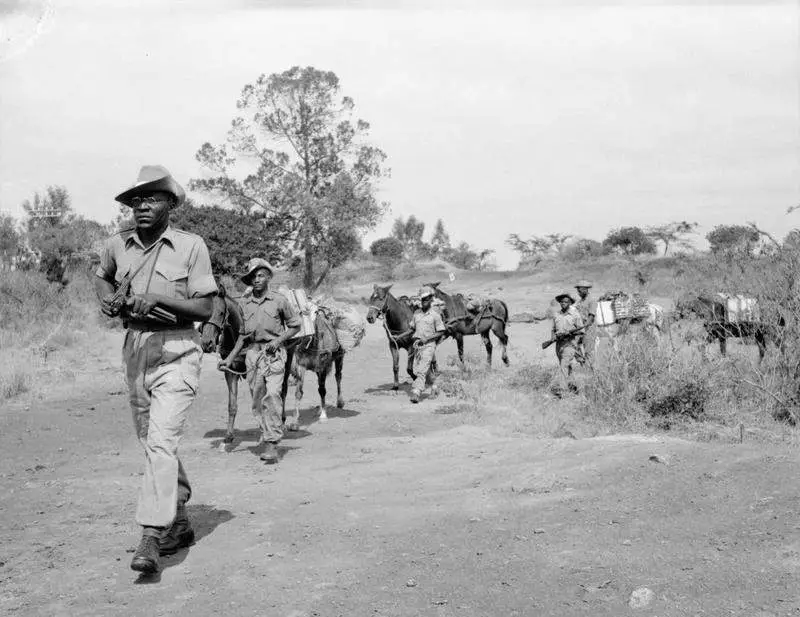Mau Mau rifle

as we want.
In case of misfortune,
We have a machine gun "Maxim",
They have no "Maxim".
Healer bellock
People and weapon. Many of us, children of the 50s and 60s of the last century, made toy weapons for ourselves to play in war, and some of our models even fired, and not only with paper caps, but also ... with Zhevelo capsules, which were then sold in hunting stores. stores are free. Some “rifles” were equipped with bolts made from... window latches. And they looked quite authentic.
However, our adults also made homemade weapons, not toy weapons, but military ones. For example, our Soviet partisans in the German rear during the Great Patriotic War. But here are homemade weapons... in Africa. Well, it is clear that spearheads and creepy-looking throwing knives were forged there at all times... But firearms... It turns out that Africans made them too, and not only made them, but also actively used them in battles against the British back in the middle of the last century.
And the most interesting thing is that the British preserved at least one copy of such a homemade gun, and it is located in the Royal Arsenal in Leeds. To be honest, I was very surprised when I came across it there while studying their virtual collection. It was called the “Mau Mau gun,” and its design could not have been simpler.
The barrel was made of a metal pipe, and at the end of the barrel a small strip of metal was cut out on both sides and bent 90 degrees. So this gun got a front sight! The barrel is connected to the stock with a metal strip, which is attached to the stock with a screw, but at the same time covers the front sight! The trigger guard is a strip of metal bent into a U shape and secured with two screws.
The bolt assembly is a metal cylinder with a firing pin inside. The cylinder slides on a concave metal plate attached to the stock with two nails. And it can be rotated to lock 45 degrees to the right, while a hollow tube, the cocking handle, fits into a cutout in the wood of the stock.
The trigger lever, connected to the trigger and the hammer mechanism, is held in the raised position by a spring. The firing pin is a bolt screwed into the bolt and sharpened. There is a small gap around the barrel where the bolt enters the barrel. When the metal tube is pulled back, the firing pin assembly is pulled into the cylindrical body. When it is released by pressing the trigger, a shot follows.
The stock consists of one piece of wood. Added to it is a fabric strap that is tied to the trigger guard and secured with two nails at the end of the forend towards the barrel. The length of the gun is 953 mm. Barrel length: 512 mm. Weight: 2 kg. Ammunition: English cartridge .303 (7,7x56 R).

Mau Mau gun from the Royal Arsenal in Leeds
Where and how the Kenyan rebels made such guns is completely unknown. But they did! Moreover, at the Independence Museum in Nairobi there is a whole display case with homemade rebel weapons, where you can find everything, including rifles and pistols!
These are the weapons in the hands of the Kenyans - and the uprising of these same Mau Mau took place exactly there, and they fought against the British colonialists. Well, we’ll talk about what kind of uprising it was, how it took place and how it ended.
It began in 1952, and such Kenyan nationalities as the Kikuyu, Embu and Meru took part in it. It is believed that this uprising got its name “Mau Mau” from the self-name of a militia group, although its participants themselves claim that they were called differently – the Kenya Land and Freedom Army (KLFA), and the British came up with the idea of calling the rebels Mau Mau.
The cause of the uprising was the colonial policies of the British Empire and the alienation of the lands of indigenous Africans in favor of white settlers. The labor laws adopted by the colonialists also infringed on the rights of African workers.
Interestingly, the white settlers were also dissatisfied with the government's policies. It seemed to them that the administration cared too much about Kenyan farmers, which infringed on the interests of them, whites. Well, native Kenyans considered the reforms proposed by the government to be clearly insufficient.
All these contradictions eventually resulted in the “Mau Mau uprising”, which began in 1950. An active guerrilla movement began in the country, killing colonial officials, white settlers and African collaborators. However, it was only in October 1952 that the British governor declared martial law in the country, after which Operation Jock Scott began, during which arrests of Mau Mau activists began.
But both these arrests and the punitive raids of the British army were not successful, primarily due to the lack of intelligent intelligence and agents in the ranks of the rebels. It seems that it was very easy to detain the insurgents, since the Mau Mau members had noticeable scars under their arms that were inflicted upon joining this “organization.” However, no matter how many of them were caught and imprisoned, there were still no fewer of them.
In response to rebel attacks, Operation Anvil was launched on April 24, 1954. The capital Nairobi was declared under a state of siege, city residents were carefully checked for connections with the Mau Mau, they searched house after house, looked for weapons, and all those identified and suspicious were sent to a concentration camp. The attacks on the partisans were carried out simultaneously by troops and aviation.
A fifty-mile ditch was dug along the forest at Aberdare and barbed wire fences were erected, along which police posts were located at a distance of half a mile from each other. All economic activity was prohibited within a radius of three miles from the forest.
It is interesting that among the participants in the suppression of this uprising was Idi Amin, the future president for life of Uganda, and at that time a sergeant in the British army, who joined the history as one of the most radical African tribalists*. However, he undoubtedly learned a lot from his commanders - the British.
Since 1955, the British began to use groups of amnestied rebels against the Mau Mau, guided by the wise rule of the colonialists “divide and rule” and “let the colored people kill the colored people.” Groups of local residents with knives in their hands had to comb the forests, moving in a chain shoulder to shoulder, and cut everyone caught into “very small pieces.”
However, the rebels were not friendly towards collaborators either. So, on the night of March 25–26, 1953, in the Mau Mau village of Lari, they burned 120 loyal Kikuyu alive, driving them into huts, along with women and children.
Later, the Mau Mau uprising became overgrown with myths and legends. Mostly with negative content regarding the Mau Mau. They say that when they killed Europeans, they devoured their corpses, that is, they practiced cannibalism, and also engaged in bestiality for ritual purposes.
There is no doubt that many of the Mau Mau's actions were exceptionally brutal. But the fact is that there were enough atrocities on both sides. Thus, Ben McIntyre and Billy Kenber on April 13, 2011, in an article in The Times, “Savage beatings and burning alive of a suspect: what the secret Mau Mau files reveal,” wrote that the Governor of Kenya reported the accusations in a telegram to the Secretary of State for the Colonies in extreme cruelty inflicted on eight European district officers.
These included "the beating and burning of two Africans during interrogation" and one officer accused of "murder by beating and roasting alive one African." Moreover, no measures were taken against the accused.
One British officer described his actions after the capture of three famous Mau Mau:

British colonial troops are engaged in suppressing the Mau Mau uprising. Photograph from the Imperial War Archives
Another white settler from the Kenya Special Reserve Police Force at the time described the interrogation of Mau Mau murder suspects in which he assisted:
The tortures were completely savage, although they were committed by seemingly civilized people. Suffice it to say that bottles, gun barrels, knives, snakes, lizards were inserted into the ripped open bellies of Kenyan men and into the vaginas of women.
It is very difficult to calculate the exact number of Africans killed, but a number of British researchers believe that there could be from 50 to 000 thousand.
But today, members of the Mau Mau are considered by the Kenyan authorities to be heroes of the war of independence, who gave their lives to liberate Kenyans from colonial slavery. The country has introduced a national holiday, Heroes' Day, which is celebrated on October 20. And again, it is interesting that it replaced another holiday dedicated to the first president of independent Kenya, who ... condemned the Mau Mau terror.
On January 21, 2019, the British newspaper Morning Star published material about the destruction by the Foreign Office (British Foreign Office) of documents on the suppression of the Mau Mau uprising. It turned out that the British Foreign Office had been lying to the public for years about how they were supposedly “lost.”
And only after several Kenyans who survived those years appealed to the London court, the Foreign Office was able to “find” several folders with documents that literally survived by miracle. And these documents confirmed both the monstrous cruelty of the colonial authorities in Kenya, and the fact that British officials tried as best they could to hide their crimes.
We found a phrase from the Attorney General of the British Administration in Kenya:
The newspaper further wrote that the British Foreign Office issued a public apology to historians for the destruction of documents on these cases. But no one is confident that he will abandon the practice of destroying documents in the future...
* Tribalism (from the English tribe - tribe) - a type of ethnic nationalism, “tribal” ethnocentrism. It is expressed in the cultural, everyday, religious and socio-political isolation of one’s ethnic community, the desire to preserve the attributes of primitiveness. It manifests itself in protectionism and the provision of privileges to the dominant ethnic community and discrimination against all others.
Использованная литература:
Anderson, David. Histories of the Hanged: The Dirty War in Kenya and the End of Empire (English). – London: Weidenfeld and Nicolson, 2005. – ISBN 0-393-05986-3. Chapter 3.
Elkins, Caroline. Britain's Gulag: The Brutal End of Empire in Kenya (English). – London: Pimlico, 2005. – ISBN 1844135489.
Blacker, John. The Demography of Mau Mau: Fertility and Mortality in Kenya in the 1950s: A Demographer's Viewpoint // African Affairs. Oxford University Press, 2007. – Vol. 106, no. 423. – P. 205–227.
Information